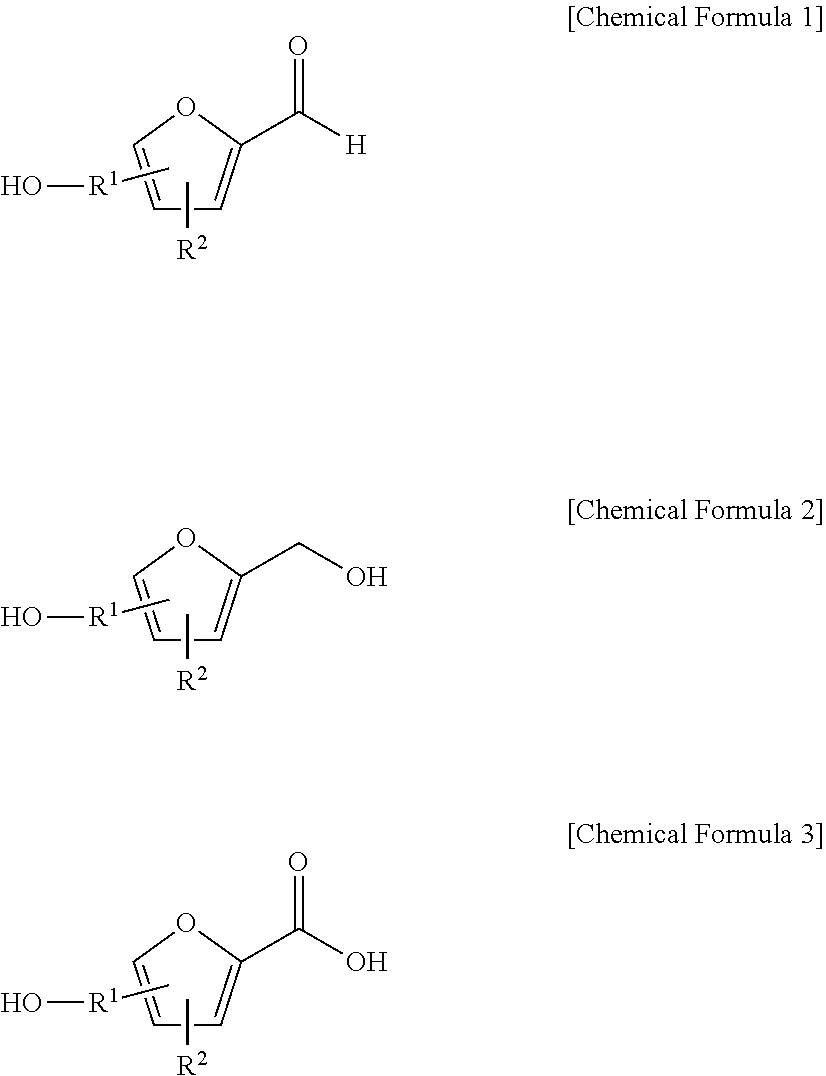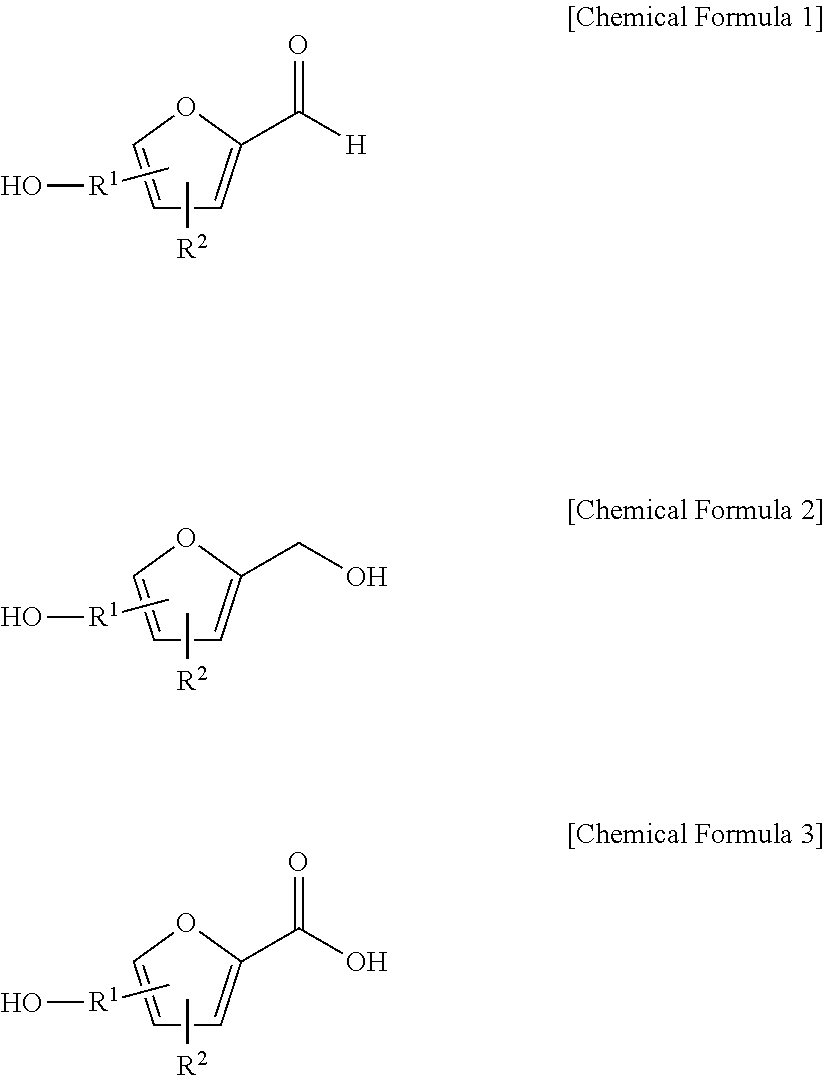Method for preparing a furfuranol-based compound and 2-furancarboxylic acid-based compound using an ionic liquid as a solvent
a technology of furfuranol and ionic liquid, which is applied in the field of preparing a furfuranol-based compound and a 2-furanol-based compound using an ionic liquid as a solvent, can solve the problems of difficult commercialization of methods, high cost of oxidants/reductants and catalysts used in conventional processes, etc., and achieves easy recovery and reuse. , the effect of simple preparation process
- Summary
- Abstract
- Description
- Claims
- Application Information
AI Technical Summary
Benefits of technology
Problems solved by technology
Method used
Image
Examples
example 1
[0061]With reference to Scheme 1 below, 1 ml of 1-ethyl-3-methylimidazolium bis(trifluoromethanesulfonyl)imide ([EMIm]TFSI, available from Merck) newly serving as an ionic liquid was placed in a round-bottom flask, 0.126 g (1 mmol) of 5-hydroxymethylfurfural (HMF, Compound I) was dissolved, the reaction temperature was adjusted to 0° C., and then sodium hydroxide powder (0.200 g, 5 mmol) was added thereto. Subsequently, the reaction temperature was increased to room temperature so that the reaction took place. After completion of the reaction, 20 ml of dichloromethane was added, after which the filtrate obtained via filtration, namely, the dichloromethane layer was distilled under reduced pressure, thus recovering the ionic liquid.
[0062]The lump of filtered particles resulting from recovering the ionic liquid was dissolved in 2 ml of water, and then neutralized with 1 N HCl, so that the pH of the solution was adjusted to about 7˜8. Extraction using ethyl acetate (3×50 ml) and then c...
example 2
[0068]DHMF and HMFA were prepared in the same manner as in Example 1, with the exception that 1-butyl-3-methyl imidazolium bis((trifluoromethyl)sulfonyl)imides ([BMIm]TFSI, available from Merck) was used as the ionic liquid instead of 1-ethyl-3-methylimidazolium bis(trifluoromethanesulfonyl)imide ([EMIm]TFSI).
[0069]The melting point of the light yellow crystals was 239.5° C., and the light yellow crystals were analyzed to be the target compound using 1H-NMR, 13C-NMR. The analytic data was as follows.
[0070]HMFA: 1H NMR (300 MHz, acetone-d6): δ 7.16 (d, J=3.4, 1H), 6.47 (d, J=3.4, 1H), 4.59 (s, 2H); 13C NMR (75 MHz, acetone-d6): δ 160.9, 159.5, 144.9, 119.6, 109.6, 57.3.
[0071]DHMF: 1H NMR (300 MHz, acetone-d6): δ 6.18 (s, 2H), 4.48 (d, J=5.8, 4H), 4.18 (t, J=5.8, 2H); 13C NMR (75 MHz, acetone-d6): δ 155.8, 108.22, 57.2.
example 3
[0072]DHMF and HMFA were prepared in the same manner as in Example 1, with the exception that 1-methyl-1-propylpyrrolidinium bis(trifluoromethanesulfonyl)imide ([PMPyrr]TFSI, available from Sigma-aldrich) was used as the ionic liquid instead of 1-ethyl-3-methylimidazolium bis(trifluoromethanesulfonyl)imide ([EMIm]TFSI).
[0073]The melting point of the light yellow crystals was 239.5° C., and the light yellow crystals were analyzed to be the target compound using 1H-NMR, 13C-NMR. The analytic data was as follows.
[0074]HMFA: 1H NMR (300 MHz, acetone-d6): δ 7.16 (d, J=3.4, 1H), 6.47 (d, J=3.4, 1H), 4.59 (s, 2H); 13C NMR (75 MHz, acetone-d6): δ 160.9, 159.5, 144.9, 119.6, 109.6, 57.3.
[0075]DHMF: 1H NMR (300 MHz, acetone-d6): δ 6.18 (s, 2H), 4.48 (d, J=5.8, 4H), 4.18 (t, J=5.8, 2H); 13C NMR (75 MHz, acetone-d6): δ 155.8, 108.22, 57.2.
PUM
| Property | Measurement | Unit |
|---|---|---|
| temperature | aaaaa | aaaaa |
| temperature | aaaaa | aaaaa |
| temperature | aaaaa | aaaaa |
Abstract
Description
Claims
Application Information
 Login to View More
Login to View More - R&D
- Intellectual Property
- Life Sciences
- Materials
- Tech Scout
- Unparalleled Data Quality
- Higher Quality Content
- 60% Fewer Hallucinations
Browse by: Latest US Patents, China's latest patents, Technical Efficacy Thesaurus, Application Domain, Technology Topic, Popular Technical Reports.
© 2025 PatSnap. All rights reserved.Legal|Privacy policy|Modern Slavery Act Transparency Statement|Sitemap|About US| Contact US: help@patsnap.com



